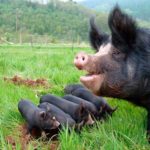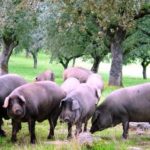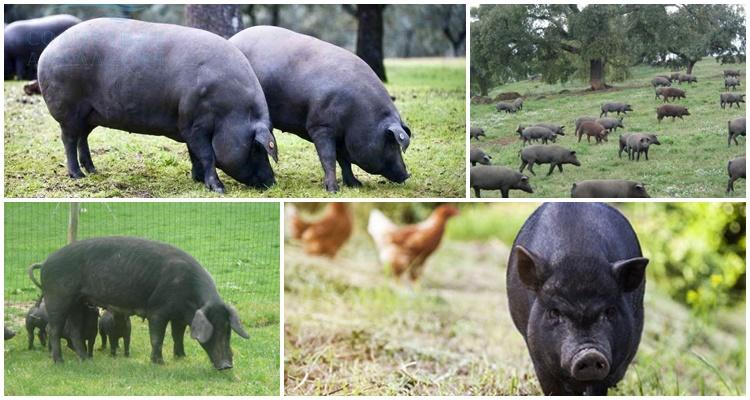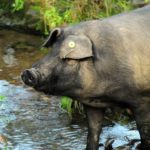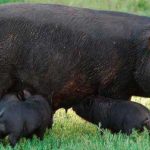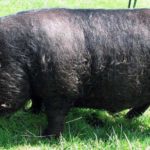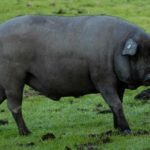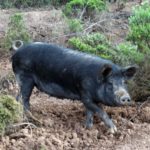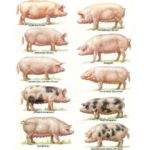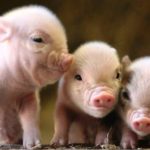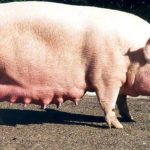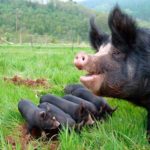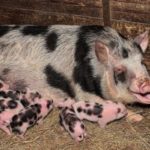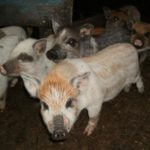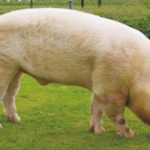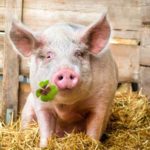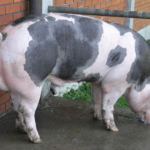Some places on the planet are famous not only for outstanding people, but also for animals that have deserved honor to humanity. The Iberian black pig gave the world a tender dried ham - jamon. This ancient breed is not much different from its wild ancestors. The Iberian pig calmly tolerates both being kept in a barn and monthly walks under the canopy of centuries-old oak trees.
Appearance and characteristics of the breed
Almost the entire body mass of the Iberian pig is concentrated in the elongated, rounded body. The black or gray skin is covered with short bristles.The powerful torso smoothly transitions into an oblong head with a snout at the end. The “piglet” of a pig consists of strong cartilage, is very mobile, devoid of vegetation and is intended for obtaining food from the ground. The trapezoidal ears are attached on both sides of the head almost at its very top and fall below the eyes, partially covering them.
The legs of the Iberian pig breed are long and lean. The outermost 2nd and 4th fingers almost do not touch the ground. There are only 4 of them. Pig legs end in hooves. This is where the name “artiodactyls” comes from. The pig's tail is disproportionately short and twisted into a spiral. The general appearance is quite athletic, without folds of fat and skin, or sagging.
Pros and cons of the Iberian pig
There is no perfection in the world. The cute Iberian pig has its drawbacks:
- very gluttonous;
- prone to obesity;
- requires sufficient areas of oak groves for its appetite with different periods of fruit ripening;
- not fertile;
- has a semi-wild disposition, determined by the same genetics.
One main plus smoothes out and overcomes all the flaws in the character and physiology of a semi-domestic animal. Incomparable marbled meat with an original flavor has made Iberia famous throughout the world.
The second advantage is that when there are not enough acorns and oak groves, the Iberian pig can be fattened with what God sent and eaten, disposing of its skin at the same time. This breed is not aggressive, either within the herd or towards humans.
Specifics of maintenance, care and feeding
The original taste of Iberian pig meat is inseparable from its living conditions.It was the natural conditions of the Spanish province that first revealed to people the way to obtain such a product in the context of domesticating previously wild animals. Pigs choose places rich in food (seeds, grains, fruits), cool and moist. They often migrate around bodies of water. Bathing cools the body of pigs in the heat, since their skin is devoid of sweat glands.
If the Iberian animal is given free rein, it will eat everything that is offered to it or finds on its own. But the manufacturer is not interested in pure lard. In order to get marbled meat, the pig needs to be given room to move. A hectare of forest is needed to walk one individual. 4 oak species with different acorn ripening periods provide food for the Iberian breed from September until almost April. It is at this time that farmers release their pets into the wild.
Wild herbs and plant roots complement the diet of Iberian pigs, making it balanced. Running around and digging the ground burns a lot of calories, and the weight of future pork increases very slowly. But only this mode of maintenance gives the signature taste of meat. In the end, Iberian pigs manage to gain 160-190 kg of weight. Then the butchers take care of them.
Breeding rules
Iberian pigs reach sexual maturity at 6 months. Delay may be caused by poor nutrition or illness. Before mating pigs, their health is checked and the best individuals of both sexes are selected through systematic observation of each animal literally from birth.
If there are males on the farm who are prepared for procreation, it is not difficult to detect heat in a female.She will begin to pay special attention to the wild boar, and may even show aggression towards gilts and sows. When a male approaches a female who is in heat, she stands still and does not run away or resist.
If mating has to be carried out with someone else's boar, the female can also be checked for readiness for it even before meeting with the breeder. The pig shows the following signs of heat:
- Swelling or redness of the vagina. It may cause bleeding.
- Unusual grunting.
- When pressed on the back, it stands still.
On average, 5-10 babies are expected per farrow. When a pig’s pregnancy is determined, it is immediately transferred to an enhanced, balanced diet. During the period of feeding piglets with milk, the mother's diet should also be high in calories, with a high protein content.
A convenient time for mating pigs is winter. The piglets will be born in 4 months.
Diseases of the breed
The owners are often to blame for the illnesses of Iberian pigs, like other animals. Improper feeding or poisoning due to inattention cause disturbances in the functioning of the digestive system.
| Disease | Symptoms | Causes |
| Anemia in newborn piglets. | Weakness, diarrhea. | Lack of iron in the diet of a pregnant sow. |
| Gastroenteritis. | Diarrhea in a piglet, developmental delay. | Malnutrition, unbalanced diet. |
| Dyspepsia in suckling piglets. | Bloating, diarrhea or constipation, lethargy, vomiting. | Malnutrition of the mother, diseases of internal organs. |
| Table salt poisoning. | Thirst, vomiting, increased salivation, convulsions. | Excessive addition of food waste containing salt to feed. |
| Mold poisoning. | Severe diarrhea or constipation. | Mold in the feed. |
| Worms. | Slow weight gain or weight loss, poor appetite. Diarrhea, regurgitation, vomiting, attempts to drag the anus along the ground. Twitching and convulsions. Parasites in feces. | Unsanitary conditions, weakening of animals due to poor nutrition. |
It is easy for animals to pick up helminths, but regular cleaning of manure slows down the spread of parasites. It is necessary to periodically give animals antihelminthic drugs.
Iberian pigs are also susceptible to viral and bacterial infections. Such diseases often accompany animals affected by parasites, penetrating into wounds caused by helminths. A change in the pig's behavior towards lethargy and despondency indicates that it is time to call a veterinarian and isolate the animal as soon as possible.
The value of meat products
The hams of Iberian pigs are used to produce many types of jamón, the most famous imported Spanish product. They differ in the method of fattening the animal from which the meat is made, and in the quality of the individual carcass. The most famous types:
- Ibérico de Beyota, for whom pig fattening ends with an acorn-grass diet;
- Ibérico Cebo de Campo is made from meat raised on grain and acorns.
Ham is dried meat from Iberian pigs with streaks of fat in the muscle. It takes several months to prepare. Cut into transparent slices.

